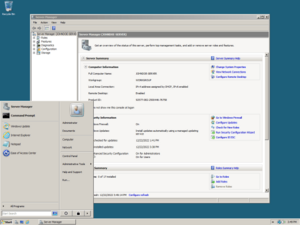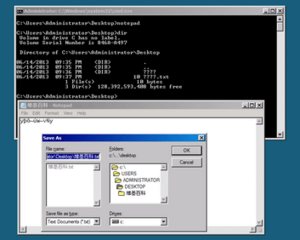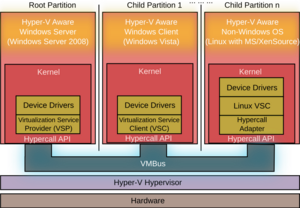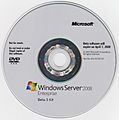Windows Server 2008 facts for kids
 |
|

Screenshot of Windows Server 2008 showing the Server Manager application which is automatically opened when an administrator logs on
|
|
| Company / developer | Microsoft |
|---|---|
| OS family | Windows Server |
| Source model |
|
| Marketing target | Business |
| Supported platforms | 64-bit: x86-64 (and originally Itanium); 32-bit IA-32 |
| Kernel type | Hybrid (Windows NT kernel) |
| Default user interface | Windows shell (Graphical) |
| License | Proprietary commercial software |
| Official website | Windows Server 2008 (archived at Wayback Machine) |
Windows Server 2008 was a special computer program, or operating system, made by Microsoft. It was designed for businesses and organizations, not for home computers. It was released in early 2008.
This operating system was built using the same core technology as Windows Vista. It was an update from Windows Server 2003 R2 and was later followed by Windows Server 2008 R2. It was the last version of Windows Server that could run on older 32-bit processors.
Contents
What is Windows Server 2008?
Windows Server 2008 was a version of the Windows NT operating system. It was part of the Windows Server family. Its main job was to help manage computer networks and provide services for many users at once. Think of it as the brain for a group of computers working together.
It was first called "Longhorn Server" during its development. Microsoft officially named it Windows Server 2008 in May 2007.
Key Features
Windows Server 2008 shared many features with Windows Vista. This is because they were built from the same basic computer code. Some of these shared features included:
- Better Networking: It had improved ways for computers to connect and share information.
- Easier Installation: Installing and setting up the system became simpler.
- Improved Security: New tools like BitLocker helped keep data safe. The Windows Firewall also got better at protecting the system.
- Better Management: Tools for checking how the system was working were improved.
Server Core

One cool feature was called Server Core. This was a simpler way to install Windows Server 2008. It didn't include the usual Windows Explorer desktop. It also left out things like Internet Explorer.
With Server Core, you managed the computer mostly by typing commands. This made the system smaller and more secure. It was harder for bad software to attack it. Server Core was great for specific jobs like running a DNS Server or a file server.
Active Directory
Active Directory is like a digital phone book for a computer network. It helps manage users, computers, and other devices. In Windows Server 2008, Active Directory got many updates.
- Easier Sharing: It allowed businesses to share login information with trusted partners.
- Better Security Certificates: It helped manage digital certificates. These are like digital IDs that let users access certain services.
- Read-only Domain Controllers (RODCs): These were special versions of Active Directory. They were useful in places where physical security might be low. They held a copy of the network information but couldn't be changed directly.
- Restartable Active Directory: You could stop and restart Active Directory without restarting the whole server. This meant less downtime for important tasks.
Hyper-V
Hyper-V is a technology that lets you run multiple "virtual" computers on one physical computer. Imagine having one powerful computer, but it can act like several separate computers at the same time. This is called virtualization.
Hyper-V helps businesses save money and space. They can run many different programs or systems on fewer physical machines. A test version of Hyper-V came with some versions of Windows Server 2008. The final version was released later as a free download.
Server Manager
Server Manager was a new tool in Windows Server 2008. It made it easier to manage the server. It combined several older tools into one place.
Server Manager gave you a clear overview of the server's status. It helped you set up new features and manage existing ones. It was designed to make server administration simpler.
Different Versions
Windows Server 2008 came in several different versions, or "editions." Each edition was designed for different needs. Most versions were available for both 32-bit and 64-bit computers.
- Windows Server 2008 Standard: A common version for general use.
- Windows Server 2008 Enterprise: For larger businesses with more advanced needs.
- Windows Server 2008 Datacenter: For very large organizations that needed to handle huge amounts of data.
- Windows Web Server 2008: Designed specifically for running websites.
- Windows Small Business Server 2008: Made for smaller companies.
Windows Server 2008 was the last Windows server operating system to support 32-bit computers.
System Requirements
To run Windows Server 2008, computers needed to meet certain requirements. These included:
- CPU (Processor): At least 1 GHz for 32-bit, or 1.4 GHz for 64-bit. Faster was better.
- RAM (Memory): At least 512 MB, but 2 GB or more was recommended.
- HDD (Hard Drive): At least 20 GB for 32-bit, or 32 GB for 64-bit. More space was always helpful.
Updates and Support
Windows Server 2008 received many updates over its lifetime. These updates included security fixes and new features.
- Service Pack 2: This was a major update released in May 2009. It added new features like Windows Search 4.0 and improved power usage.
- Internet Explorer 9: This was the last version of Internet Explorer supported on Windows Server 2008. It received updates until January 2020.
- Monthly Updates: Starting in September 2018, Microsoft began releasing monthly update packages. These included security and quality improvements.
Microsoft stopped providing free support for Windows Server 2008 on January 14, 2020. This meant that after that date, regular security updates were no longer available for free. Some businesses could pay for "Extended Security Updates" for a few more years. This program ended for most customers in January 2023 and for Azure customers in January 2024.
Windows Server 2008 R2
A newer version, called Windows Server 2008 R2, was released in 2009. This version was based on Windows 7. It brought even more improvements, especially in virtualization. It was also the first server operating system from Microsoft that only supported 64-bit processors.
Images for kids
See also
 In Spanish: Windows Server 2008 para niños
In Spanish: Windows Server 2008 para niños



